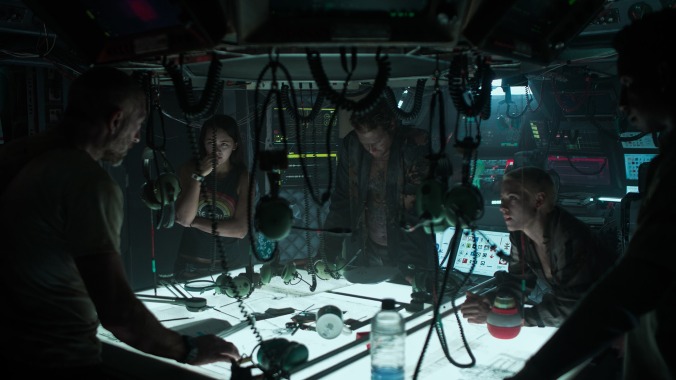The derivative Alien gloss Underwater comes close to the platonic ideal of a January release


Compared to the average Hollywood blockbuster, the sci-fi horror film Underwater looks like a model of narrative and stylistic efficiency, even as it borrows shamelessly from other, better movies. It’s the future. Enormous corporate deep-sea drilling operations sit miles below the surface on the ocean floor. In the opening sequence, a drilling platform called Kepler Station begins to collapse after being hit with what appears to be a massive undersea earthquake. The corridors groan and buckle, turning into a terrifying Slip ’N Slide as an engineer named Norah (Kristen Stewart) and a station crewman named Rodrigo (Mamoudou Athie) scramble frantically to seal a bulkhead.
Sifting through grimy, mucky wreckage, they find more survivors: Paul (T.J. Miller), a tattooed oddball who carries around a stuffed bunny for good luck; Emily (Jessica Henwick), a science intern; the station’s dutiful captain, Lucien (Vincent Cassel); and Norah’s friend Smith (John Gallagher Jr.). The station’s remaining escape pods are damaged and so is the power plant, which could blow at any minute. Waiting for a search and rescue team is out of the question. The survivors’ only option is to make their way to the base of the station and cross the ocean floor in high-tech diving suits in the hope that they can get to an even deeper drilling platform.
The director, William Eubank, delivers an act’s worth of exposition in the first 15 minutes, and the rest of Underwater proceeds at a similarly economical pace. Kepler Station sits more than six miles under the ocean surface, deep in the permanent darkness of the hadal zone. The pressure is about a thousand times the Earth’s atmosphere, which is enough to instantly pulverize a human body (a fact that the movie illustrates early on with all the gruesomeness allowed by a PG-13 rating.) But there are other dangers lurking on the ocean floor. Awakened by our incessant drilling, spiny, gooey deep-sea Lovecraftian lifeforms with stretchy jaws have come out of the far depths.
The premise recalls the late-’80s deep-sea creature features Leviathan and DeepStar Six, but the comparison is unfair; Underwater is both more consistent and more atmospheric than either of those movies, making the most of Bojan Bazelli’s grungy, gothic lighting and the dingy walls and flickering screens of Naaman Marshall’s industrial production design. Though it pays “creative homage” to a number of films (the opening credits sequence is practically lifted from the 2014 version of Godzilla), it owes its biggest debts to Alien, Aliens, and the collected works of Paul W.S. Anderson, the sci-fi deathtrap B-movie maestro behind Event Horizon and the Resident Evil films.
Anderson, himself an Alien and Aliens fanatic, is not an unwelcome influence, and one would like to believe that Underwater’s references to Alice In Wonderland (another Anderson obsession) are a conscious nod. Like a lot of his films, Underwater also owes something to video games, mostly various descendants of System Shock, using both environment and sound design—like the prerecorded announcements that loop through station corridors—for both exposition and irony. It also shares a few problems with just about every movie that has tried to recreate the Alien formula: The characters aren’t as interesting as the crew of the USCSS Nostromo, and the monsters aren’t as unsettling and indelible as the original Xenomorph. They are best kept in the dark.
Fortunately, Eubank is able to keep up a persistent sense of confinement and doom for most of the film. His last movie, the sci-fi indie The Signal, was little more than a collection of calling-card moments, which apparently worked well enough to land him this gig. For all of its flashy designer qualities (including a weakness for bombastic slow-mo), his direction in Underwater is a massive leap forward; it’s streamlined, rarely losing sight of its objective of getting the characters from point A to point B while goosing the requisite jump scares. He plants the camera claustrophobically close to actors’ faces inside the fishbowl helmets of the diving suits and plunges miles through murky waters in an establishing shot.
Splashing water on the camera lens and letting the droplets catch the dim light as the characters clamber through collapsed concrete in panic mode is a classic trick, but it works. Throughout, Underwater is aided by the able cast led by Stewart. With her hair buzzed short and dyed blond, she makes a credible fashion-week Ripley, complete with high-top sneakers and tight-fitting skivvies. (Though Eubank’s camera seems to mock its own ogling by also offering up a sweeping close-up of Miller’s ass in ripped boxers.)
Filmed in the first part of 2017 (which explains the prominent role given to Miller, whose career began to publicly implode later that year) and delayed by Disney’s acquisition of 20th Century Fox, Underwater feels in stretches like the platonic ideal of a January release—one of those delectably unpretentious and industrious true Hollywood B-movies consigned to the winter dumping ground by a franchise-obsessed, superhero-crazed major studio. But unlike the best programmers, it never transcends its derivative origins and basic thrills. It’s another movie about thin characters and bland monsters—albeit one that’s better than the norm.